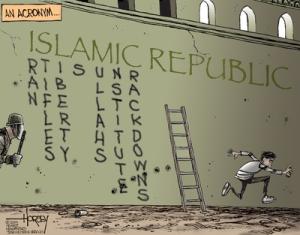- MENU
- HOME
- SEARCH
- WORLD
- MAIN
- AFRICA
- ASIA
- BALKANS
- EUROPE
- LATIN AMERICA
- MIDDLE EAST
- United Kingdom
- United States
- Argentina
- Australia
- Austria
- Benelux
- Brazil
- Canada
- China
- France
- Germany
- Greece
- Hungary
- India
- Indonesia
- Ireland
- Israel
- Italy
- Japan
- Korea
- Mexico
- New Zealand
- Pakistan
- Philippines
- Poland
- Russia
- South Africa
- Spain
- Taiwan
- Turkey
- USA
- BUSINESS
- WEALTH
- STOCKS
- TECH
- HEALTH
- LIFESTYLE
- ENTERTAINMENT
- SPORTS
- RSS
- iHaveNet.com
by Paul J. Saunders

Situation in Tehran does not simply mirror 1950s Hungary or 1980s Poland ... or even 1979 Iran
Paul J. Saunders is executive director of the Nixon Center and served as a Bush administration
Outrage over the Iranian government's violent suppression and intimidation of dissent has appropriately produced considerable concern in the United States and fueled a debate over U.S. policy toward Tehran.
Many political leaders and pundits have called for more active and vocal American support of the Iranian opposition, typically on the basis of analogies to oppressive regimes of the twentieth century.
Unfortunately, the vast majority of these analogies are misleading and even dangerous if used as guides to policy. The historical cases most similar to present-day Iran should instill caution.
Some have compared Iran to the Philippines in 1986 or South Korea in 1987, both cases in which the Reagan administration lent support to domestic groups pressing for greater democracy (after a stolen election in the Philippines and in restoring direct presidential elections in Korea).
These two analogies are both fundamentally flawed because both countries were American allies over which the United States had considerable leverage. To the extent either case can be compared to Iran, they are more similar to the Iran of 1979 than 2009.
Others warn that Iran is headed toward a situation similar to 1989's Tiananmen Square.
This implicitly suggests that the George H. W. Bush administration could have prevented the Chinese government's decision to crack down on China's pro-democracy protesters, which seems doubtful but is ultimately unknowable. However, the focus of this comparison is typically criticism of the Bush administration's post-Tiananmen engagement with China.
Either way, there has thankfully been no event on this scale in Iran. Partially motivated by the collapse of communism in Central Europe, Tiananmen also demonstrates the potential danger of using strategies that were successful in one place and time in a radically different environment. (Though the blame for the outcome lies overwhelmingly with the Chinese government, not the protesters.)
The bulk of the history lessons filling editorial pages have to do with America's Cold War and modern policies toward the U.S.S.R. and former Soviet bloc countries. Some mention Hungary in 1956--when the U.S. essentially encouraged a revolt via Radio Free Europe but was ultimately unwilling to come to aid the country's revolutionaries--or the Prague Spring in 1968, which Washington did not particularly encourage beforehand or support afterward. Both demonstrate the calculations that have led past American leaders, Republican and Democratic, to shy away from active intervention in such circumstances.
Others cite the Reagan administration's support for Poland's Solidarity trade union movement in the early 1980s, though few acknowledge that the Solidarity protests led to the imposition of martial law and considerably greater repression. Poland did not have a non-communist government until 1989, nine years after the first Solidarity strikes. The fact that Soviet leaders--and Polish and other Central European leaders--were no longer prepared to use large-scale violence to suppress opposition was decisive in the largely peaceful revolutions of 1989.
Ukraine's 2004 Orange Revolution is another popular case, doubtless because it is a recent example of electoral fraud akin to Iran's and because American political intervention was important to Viktor Yushchenko's eventual installation as president. Yet "revolution" is clearly an overstatement of the degree of change in Ukraine and its subsequent governments have been quite unstable. Actually, the country's recent history is an illustration less of the success of U.S. pressure in producing democracy than of the fact that democracy requires much more than the 'right' election outcome, especially in a divided country.
Finally, many talk of the Soviet Union, especially of President Reagan standing up to Soviet leaders or Reagan and others supporting Soviet dissidents.
U.S.-Soviet relations are mostly irrelevant to Iran, however. At the time of the Cold War, the U.S.S.R. was the pre-eminent threat the American national security and was a global competitor. The United States subordinated much of its foreign policy to the U.S.-Soviet rivalry. Few today seem prepared to afford Tehran the same role in shaping U.S. global policy and strategy, notwithstanding the real danger of Iran's nuclear ambitions and its regional support for terrorism. Moreover, America's defense of Soviet dissidents was a long-term strategy, like support for Solidarity, not one expected to produce the immediate results for which today's observers appear to hope.
One of the most wrong-headed comparisons between Iran and the former U.S.S.R. is the comparison to the
Historical patterns can clearly be useful tools for thought and action in shaping policy, but in using them it is essential to avoid becoming locked in to psychologically appealing narratives that can skew expectations.
It is likewise important to remember that history took a long time to happen and that most of the decisive events to which we look back were the final stages of extended processes.
What does this mean for U.S. policy toward Iran? Stay calm -- and don't try to turn today's events into something they are not.
WORLD | AFRICA | ASIA | EUROPE | LATIN AMERICA | MIDDLE EAST | UNITED STATES | ECONOMICS | EDUCATION | ENVIRONMENT | FOREIGN POLICY | POLITICS
Iran Election Historical Analogies Are Misleading and Dangerous: Situation in Tehran does not simply mirror 1950s Hungary or 1980s Poland or even 1979 Iran - Senator John Kerry